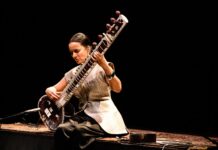
BY INDIRA PRAHST
Vancouver sociologist
MORE than 300,000 people flocked to last Saturday’s Khalsa Day Parade in Surrey organized by the Gurdwara Sahib Dasmesh Darbar – the largest Vaisakhi parade outside of India.
The bright sunshine and the gorgeous cherry blossoms added a delectable touch to the robust celebrations. It was a resounding success, indeed, with many participants saying that they were overwhelmed by the sea of colourful turbans on the streets.
People of all religions and cultures celebrated the joyous occasion as Satinderpal Singh Gill, a senior member of the gurdwara, pointed out to me: “Everyone is invited and we see how much people want to be together.” And President Dewinder Singh Grewal noted: “This is to remember the creation of the Khalsa in 1699. This is important because it is the basis of what the Sikh faith is formed on and to also fight oppression worldwide.”

This year’s procession featured 19 floats representing local Sikh schools, community groups, humanitarian organizations, as well as the most important float in the procession that carries the Guru Granth Sahib (Sikh Holy Scripture), gurdwara spokesperson Moninder Singh said.
The spirit of Vaisakhi and celebration of the birth of the Khalsa were clearly manifest throughout the day, with families enjoying the food and watching the floats or listening to speeches or watching performances from different stages set up along the parade route. On the main stage a raft of speakers spoke on diverse topics ranging from the birth of the Khalsa to human rights issues, including Khalistan. This year, Roopinder Kaur and Mandeep Kaur, daughters of Bapu Surat Singh Khalsa, spoke about their father’s hunger strike in Punjab to free political prisoners, his incarceration and the detainment of their brother.
A positive energy pervaded the parade with enthusiastic people doing “seva.” They included the youth from the Guru Nanak Free Kitchen who devote much of their time throughout the year preparing free food for the down and out of all ethnic and religious communities without hardly any media coverage.

Photo by Indira Prahst
As usual, while hundreds of thousands enjoyed the parade, some were looking out for controversial floats. Some Sikh youth did not view the floats depicting pictures of people they consider to be martyrs as well as pro-Khalistan images and flags as controversial. Instead, they viewed it as freedom of expression to showcase their history from a Sikh lens. “The political cannot be separated from Sikhi” was a common thread in many of the speeches throughout the parade. This year, there was also a “Communities United Against Narendra Modi” float to protest against the Indian Prime Minister organized by 25 organizations which provided a visual historical narrative of human rights violations in India.
Some youth believed that floats at the parades also function to raise awareness about Sikh issues. Issues in Punjab are important to draw public attention to because it is where Sikhism originated from and Punjab has always been the breadbasket of India, they note. Accordingly, some floats provided information about how the environment’s deterioration is adversely affecting people in Punjab. Fact sheets were handed out to educate people about Sikhi, the birth of the Khalsa and struggles in Punjab.
Several people at the Khalsa Day parade felt it was a great event, and both the past president, Gian Singh Gill, and the current president told me at the event that they were thrilled to see everyone come together in such large numbers to celebrate the birth of the

Photo by Indira Prahst
Khalsa. What was especially important was that the meaning of the event was preserved, remembering the birth of the Sikh faith which Guru Nanak Ji started and the creation of the Khalsa Panth by Guru Gobind Singh Ji.
Dashmesh Gurdwara President Dewinder Singh Grewal told me: “When I came to Canada 47 years ago, there were not too many Sikhs here. But after 1984, the numbers increased which you could tell at the Nagar Kirtans and there are so many young Canadian-born Sikhs. Khalsa Day is a very special day for us at the gurdwara where we have more than 150 people that get baptized on that day.” Grewal added that in the last five years there has been an increase in Sikhs taking Amrit. Indeed, there is hope by some committee members that more Sikh youth will become Amritdhari and follow the Panth.

Photo by Chandra Bodalia












